Famous places to see in Ladakh
Leh
Ladakh has a capital with best places to visit with numerous Temples, Castles, Monasteries, Stupas, and Maney walls that the ancestral Dharmarajas built. Leh was 1st of all the capital of king Tagpa Bum-Lde, who ruled over the area of Stod and Leh from 1400AD to 1430AD. It was him who build the Red Chapel containing the statue of the Buddha Maitreya, three storey in height with the statue of Avalokiteshvara and Manjushiri on either side , each one storey high.

Place to see in Leh City and around
The Leh Palace;
Leh Palace also known as Lhachen Palkhar or Namgyal Palace Is a nine storied building which is truly a one piece structure not only in this country but in the whole world. This building is also the oldest nine storied building in the world. King Singe Namgyal, who was the greatest king of Ladakh more than 350 years ago, built it.
The king who reigned from 1616 to 1642 built the magnificent building in the late 1630s. It took around three years to complete the building of the structure. The main façade measures 60 meters in width and 58 meters in height. They constructed its massive masonry using the rammed earth technique, with foundations and cross walls providing buttressed support to the external south wall and the internal spine walls. The heavily battered wall are at least 1.75m thick at the base and diminished to 0.5mt where the rammed earth changes to sun baked bricks.
They constructed the palace with nine storeys, possibly considering the auspicious number nine in accordance with Tibetan Buddhism or Culture. Following tradition, they dedicated the upper section to noble uses, including Royal apartments, State rooms, reception halls, two temples, and rooms utilized for religious purposes. The lower sections were for staffs, Storage silos and Stables. In 1836 during the military expedition by the Dogra’s, the palace suffered partial damage. The ASI (Archaeological Survey of India) is currently renovating and reconstructing the palace.
The Namgyal Tsemo(victory peak);
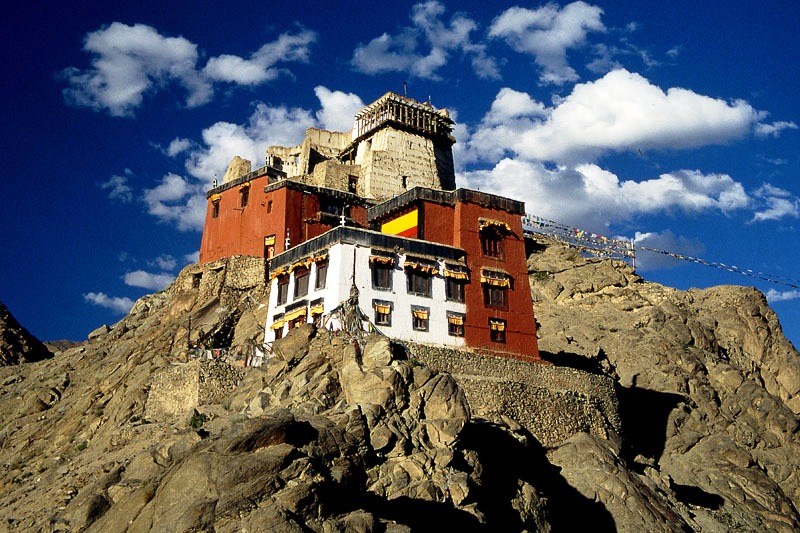
During the lifetime of King Tashi Namgyal, who ruled from 1500 AD to 1532 AD, he built the temple of Namgyal Tsemo. King Tashi Namgyal himself reunified upper and lower Ladakh and emerged victorious against the Hor (central Asian invaders). They placed the bodies of the Hor invaders under the image of Mahakala, the guardian deity, to subdue their spirits and prevent any future invasion by the Hor.
Tsemo Gonpa;
King Gragspa Bum-Lde built the “Red Gonpa,” known as Tsemo Gonpa, in 1430 AD. The monument has three storey statue of Maitriya Buddha and a one storey statue of Avaloketeshvara and Manjushiri. They wrote the Tsemo Sungbum Chenmo (sacred text) in Gold and Silver.
Ti-siru Stupa;
During the period of Dragspa Bum Lde, they built this Stupa. It has around 108 stupas inside.This stupa is located near Sankar village or near Shanti Stupa.
Sankar Monastery (Pethub)
Sankar Monastery, is within an easy half-hour walk from Leh. It is a branch of Spituk Monastery and the residence of the Abbot of Spituk, the Venerable Kushok Bakula, who is the senior incarnate lama of Ladakh due to his ancient lineage and personal authority. .There are more than 20 monks at the monastery. Climbing the steps one reaches the double doors leading into the dukang (‘du khang) or assembly hall.
On the right of the door, they placed three green drums below which is the place of the Gyeskos. Upstairs is the Dukar Lhakang (“residence of the deity”) or inner sanctuary. There is an impressive figure here of Avaloketeswara (Tibetan: Chenrazig) with 1,000 arms (all holding weapons) and 1,000 heads. They painted the walls with a Tibetan Calendar, Thankas, Protectors, Deities, and rules for the monks. Above the wooden stairs, you can see the rooms of the Abbot, guest rooms, and the library.
Spituk monastery
Arhat Nyimagung visited and blessed the location of Spituk, which is located about 8 km from Leh. Od-de, the older brother of Lha Lama Changchub Od, established it in the 11th century when he traveled to Maryul. He introduced the monastic group. Lotsewa Rinchen Zangpo, the translator, predicted that a model religious community would form there and named the monastery Spituk or Pethub (exemplary).

Lama Lhawang Lodos restored the monastery during the time of Dharma raja Gragspa Bum-Ide and introduced the stainless order of Tsonkhapa, which has remained intact until the present. In the 15th century, the Yellow Hat sect took over the monastery, despite its original foundation as a Red Hat institution. The monastery accommodates 100 monks and showcases a giant statue of Kali, which they unveil during the annual Spituk festival.Every year, from the 27th to the 29th day of the eleventh month of the Tibetan Calendar, Spituk hosts the Gustor festival.
Spituk has an average elevation of 3,307 metres (10,852 feet).
North Ladakh
Nubra Valley (Valley of flowers)
Nubra or Ldumra situates in the northern part of Ladakh at an altitude of about 10,000ft above sea level. The main settlements are along the Shayok and Siachen river. The river belt areas are sandy and the vegetative cover includes green Farmarisk and Myricaria. Sand Dunes between Hunder and Diskit village is one of the main feature of Nubra valley. This valley was the ancient trade route that linked the North Indian plains with Central ancient cities of Yarkand and Khotan, a trade route which existed until 1949, when Chinese firmly closed the border. You can reach Nubra by road by traversing from Leh across the Khardungla pass on the Ladakh Range.
Khardung la Pass
The 39km stretched road to Khardungla is good till half way (till South pullu), it gets little bumpy with snow melt carving patterns on the roads.With its elevation reaching 18,380 ft or 5,600 meters above sea level, the world-famous Khardung La holds the distinction of being known as the highest motorable road in the world.You can witness the great Stok Kangri and Golep Kangri of Stok Range and Zanskar range beyond it. In the north, you can view the great Karakoram Range. You will also witness motorcycles and cyclists earning bragging rights for conquering the world’s highest motorable pass.
Places to see in Nubra valley ;
Diskit monastery
Built in around 1340, Diskit Monastery is the oldest and largest Buddhist monastery (Gonpa) in the Nubra Valley . It belongs to the Gelukpa (Yellow Hat) sect of Tibetan buddhism. And this place is also one of the good places to visit in Ladakh.
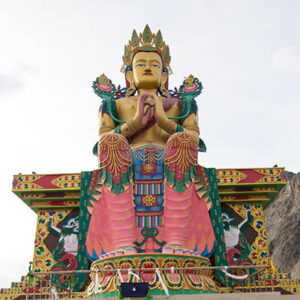
Changzem Tserab Zangpo, a disciple of Tsonkhapa, the founder of Gelukpa, founded it in the 14th century. It serves as a sub-Gonpa of the Thikse Gonpa. Diskit monastery has biggest statue in Ladakh with its height of 105 feet. They built and finished it in 2010, and H.H. Dalai Lama inaugurated or blessed it.
During the winter season in February, people from villages in the Nubra Valley actively participate in a popular festival called Dosmoche, also known as the “Festival of the Scapegoat.” The festival takes place within the precincts of the monastery. It serves as a means for the villagers to gather and celebrate since heavy snowfall makes other regions in Leh inaccessible during this period.
Hunder
Hunder village is around 7 km away from Diskit village. On a way you will come across the sand dune of the village where you can find double hump Bactrian camels waiting for the tourist to ride around the Dunes. It has a nice stream too flowing through. These Camel reminds you of the famous Silk Route.
At Hunder, there is a monastery which is more than 500 years old and one of the only witness of the great Shayok flood that washed away almost everything. Here you can visit Zimskhang, the another survivor of the big flood.
Sumur
Sumur is the largest village in the Nubra Valley across the Shayok River along lush green meadow. Samstenling Monastery founded by Lama Tsultim Nima more than 150 years ago, is the biggest attraction of Sumur. The monastery comprises of seven different temples and has a huge collection of Thangkas and arduously restored frescoes. And just besides the Sumur village, here is a village of Tegar.
Eastern Ladakh
Shey Palace
The Palace complex is located on a hillock in Shey, 15 kilometres (9.3 mi) to the south of Leh in Ladakh, northern India on the Leh-Manali road.
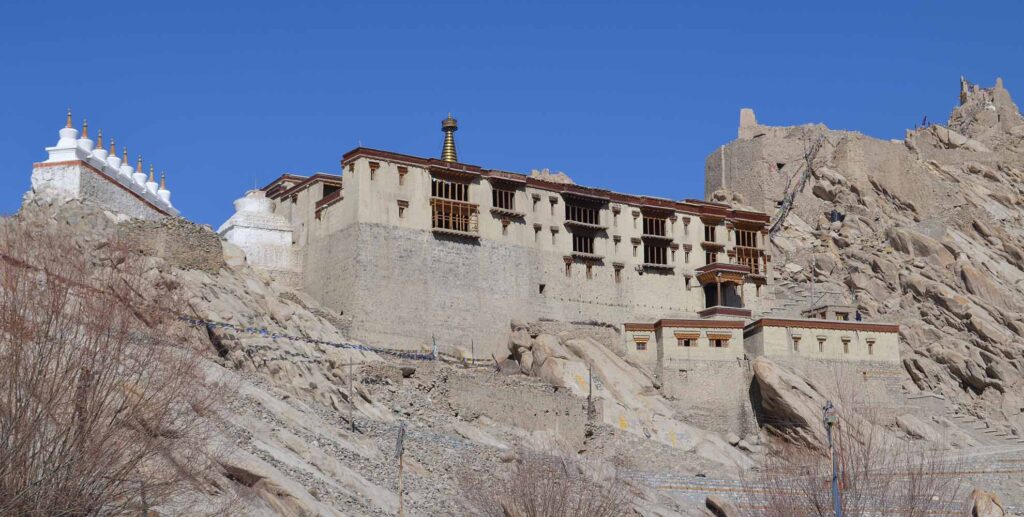
The king of Ladakh, Deldan Namgyal, also known as Lhachen Palgyigon, built the palace first in 1655 near Shey village. The palace, which is mostly in ruins now, served as a summer retreat for the kings of Ladakh. Delden Namgyal instructed the construction of the Shey Monastery in 1655 within the palace complex as a memorial to his late father, Singay Namgyal. The monastery gained renown for its giant copper statue of a seated Shakyamuni Buddha, which they gilded with gold. This statue is deemed unique within the entire region of Ladakh.
Furthermore, near the Shey Palace, people can find a rock carving of Five Dhyani Buddhas that experts believe dates back to the 11th century.
Thiksay Monastery
Thiksay Monastery located on top of a hill approximately 19 kilometres (12 mi) east of Leh . It is renowned for resembling the Potala Palace in Lhasa, Tibet, and many consider it the most beautiful Gonpa (monastery) in central Ladakh.
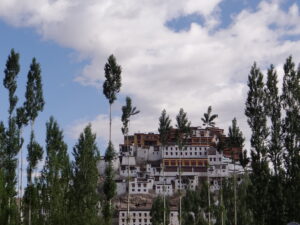
The monastery is located at an altitude of 3,600 metres (11,800 ft) in the Indus Valley. It is a twelve-story complex and houses many items of Buddhist art such as Stupas, statues, Thangkas, wall paintings. One of the most beautiful thing to see at Thiksey monastery has a two storey statue of Buddha Maitreya, which was made in 1980 and got it blessed by H.H.Dalai Lama.
In the mid 15th century, Palden Sherab Zangpo continued the monastic work started by his teacher, Sherab Sangpo. He decided to build a larger monastery here that was dictated by an unusual event that occurred while choosing a site. Legends narrate that Tsongkhapa had predicted that his doctrine would prosper on the right bank of the Indus River. This prediction came true when the Thiksey Monastery was established. This was followed by others such as the Spituk and Likir Monastery, which are also situated on the right bank of the Indus.
Stakna Monastery
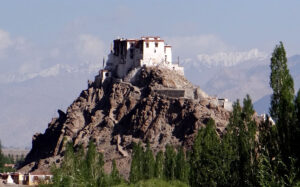
Monastery is a monastery of the Drugpa sect and is 21 or 25 kilometres from Leh on the left bank of the River. It was founded in the late 16th century by a Bhutanese scholar and saint, Chosje Jamyang Palkar. The name, literally meaning ‘tiger’s nose’ was given because it was built on a hill shaped like a tiger’s nose. Of note is a sacred Arya Avalokitesvara statue from Kamrup, Assam. Stakna has a residence of approximately 30 monks. The branch monasteries of the monastery are Sani, Bardan and stakrimo in Zanskar.
Stok Palace
Stok palace is 14 km away from Leh which lies in the south east of Leh. The palace was built in 1825 by the king Tsespal Tondup. Around in 1834, the royal family was forced to flee to Stok palace when Zorawar Singh attacked. He wathe army general of Dogra king annexed Ladakh and ended the Kings rule of Ladakh. The royal family still lives at the palace. At present the palace museum has a collection of Royal dresses, Kings Crown, Ornaments and Jewels etc.
Gurphuk Gonpa, a branch of Spituk monastery is little far from the palace. Every year a festival called “Stok Guru Tseshu” is held on 9th and 10th of 1st month of the Tibetan Calendar. During this festival two Oracles show up and make predictions for the next year or the coming months.
Matho monastery
Founded in 1410 century by Lama Dugpa Dorje, it belongs to the Sakya Order., Matho Monastery, Mangtro Monastery or Mangtro Gonpa, from the Tibetan “mang” that means “many” and “tro” that means “happiness”, is located 26 kms southeast of Leh , on the banks of the Indus River. The village of Matho is located at the mouth of a deep gorge running out of the Zanskar Range and across the Indus. It is directly opposite Thiksey Monastery.
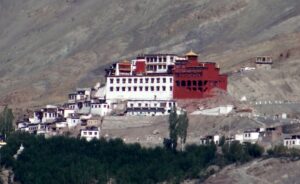
Matho is the only example in Ladakh of the Sakyapa sect of Tibetan Buddhism. Because it does not lie on the main highway from Leh, it sees fewer visitors than Hemis, Thiksey or Shey.
During the annual Oracle Matho Nagrang Festival, which takes place on the 14th and 15th days of the first month of the Tibetan calendar, two oracles known as “Rongtsan” temporarily inhabit the bodies of two monks.
The purpose of these oracles is to attempt to predict the fortunes of the local village communities for the coming year. Once every two years, a monk is picked to be a medium for the oracles for a period of four years. In the first year, the selected monk will have to meditate for nine months before the festival. The three next years the meditation will last 3 months.
Matho is also home to a collection of Thangkas dating back to the 14th century.
Hemis Monastery
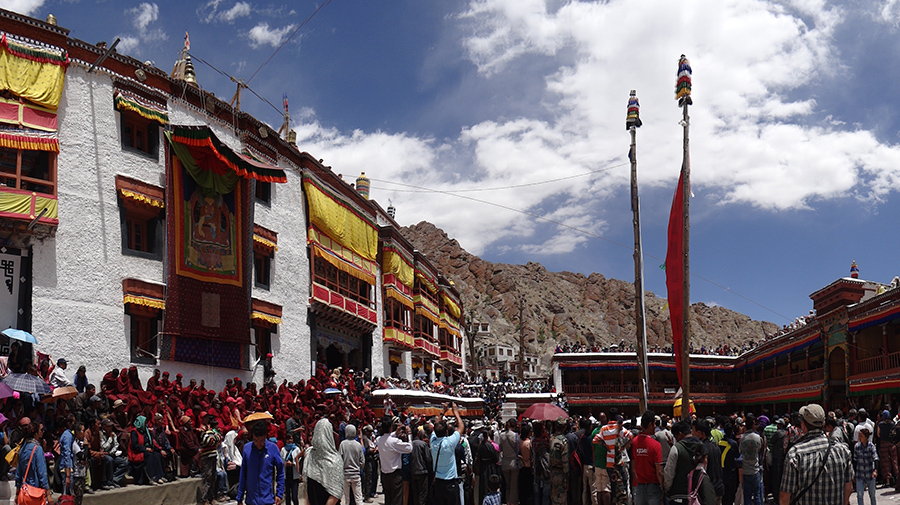
Hemis monastery, located 48 kms away from Leh, is famous as the richest and the biggest monastery of Ladakh. The first Stagsang Raspa, who was summoned by King Singay Namgyal, constructed it in 1630. The Tibetan Buddhist Drukpa sect pertains to this monastery.
People dedicate the Hemis Festival to Lord Padmasambhava (Guru Rimpoche), whom they venerate as the representative reincarnate of Buddha and the focal point of the Dance Performance at Hemis Monastery. They believe that Lord Padmasambhava was born on the 10th day of the fifth month of the Monkey year, as predicted by the Buddha Shakyamuni. The purpose of his life was and continues to be the improvement of the spiritual condition of all living beings. Once in a cycle of 12 years, they exhibit a special Thanka on this day. The last exhibition took place in 2004.
Hemis also has a very beautiful museum with a souvenir shop.
Chemrey Monastery
Chemrey Monastery is a 1664 Buddhist monastery, approximately 40 kilometres (25 mi) east of Leh. The Drugpa monastic order belongs to it, and the Lama Stagsang Raspa founded it and dedicated it to King Namgyal. The monastery has a notable high Padmasambhava statue. It also contains a valuable collection of scriptures, with title pages in silver and the text in gold letters. The monastery is also a venue for the festival of sacred dances which takes place on the 28th and 29th day of the 9th month of the Tibetan calendar every year
Tak-Thak
Takthok Monastery (also known as Thag Thog or Thak-Thak) is in Sakti , located approximately 46 kilometres east of Leh. They named it Takthok, literally meaning ‘rock-roof,’ because they made both its roofs and walls out of rock.It belongs to the Nyingma tradition of Tibetan Buddhism and approximately 55 lamas reside there. It is the only Nyingma monastery in Ladakh.
Tsewang Namgyal founded the monastery on a mountainside around a cave where Padmasambhava is said to have meditated in the 8th century during his reign in the mid-16th century. Every year, on the 9th and 10th day of the sixth month of the Tibetan calendar, the monastery holds celebrations (Tak-Thak Tseshu) that include sacred dances.
Korzok,
Korzok belonging to the, Drukpa Lineage and ancient village on the western bank of Tsomoriri Lake in Leh District. It is, situated at 4,595 metres (15,075 ft), houses a Shakyamuni Buddha and other statues. It is home to about 70 monks. In the past, the monastery was the headquarters of the Rupshu Valley. It is an independent monastery under Korzok Rimpoche, widely known as Langna Rimpoche. The 3rd Korzok Rimpoche, Kunga Lodro Ningpo was the founder of Korzok Monastery.
This revered monastery is 300 years old and the locals consider it equally sacred. Consequently, they have developed the area for tourists.
The monastery holds the Korzok Gu-stor festival, which attracts many Chang-pa, the Tibetan plateau nomadic herdsmen. The festival lasts for two days (July/August) and ends with the dismemberment and dispersal of the ‘Storma’ (sacrificial cake) by the leader of the Black Hat dancers in a ceremony called ‘Argham’ (Killing).
Lakes of Ladakh
Brief Info:
Ladakh, a region in the Indian state of Jammu and Kashmir, is known for its stunning lakes that offer breathtaking beauty and serenity. Here are some of the prominent lakes in Ladakh:
Pangong Lake
The Lake is an endorheic lake in the Himalayas situated at a height of about 4,350 m. It is 134 km long and extends from India to Tibet. It is said that, 30% of the lake is in India and rest is in China. During winter the lake freezes completely, despite being saline water. It is not part of Indus river basin area and geographically a separate land locked river basin. The lake is in the process of being identified under the Ramsar Convention as a wetland of international importance. The lake acts as an important breeding ground for a variety of birds including a number of migratory birds. During summer, the Bar-headed goose and Brahmini ducks are commonly seen here. The region around the lake supports a number of species of wildlife including the Skiang and the Marmot.
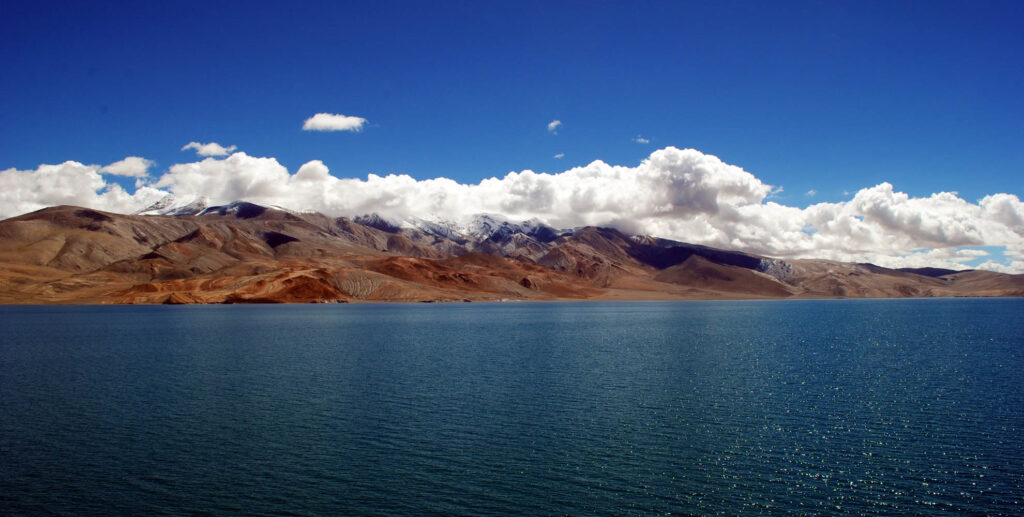
Tsomoriri Lake
Tsomoriri Lake is one of the most beautiful natural lake in Ladakh and it lies in the region of “Changthang” east of Ladakh. Lake has a source of fresh water coming from the mountains. Lake is in front of Korzok village and monastery which was built in 1630. During winter, the whole lake freezes, so the nomads walk on frozen lake to go to other side.
Tsomoriri is a home for more than 3000 migratory Birds and 250 species. These are like Brown Headed Gulls, Horned Lark, Red-billed Chough, species of Wagtails, Tibetan Snow finch, Crag martin etc
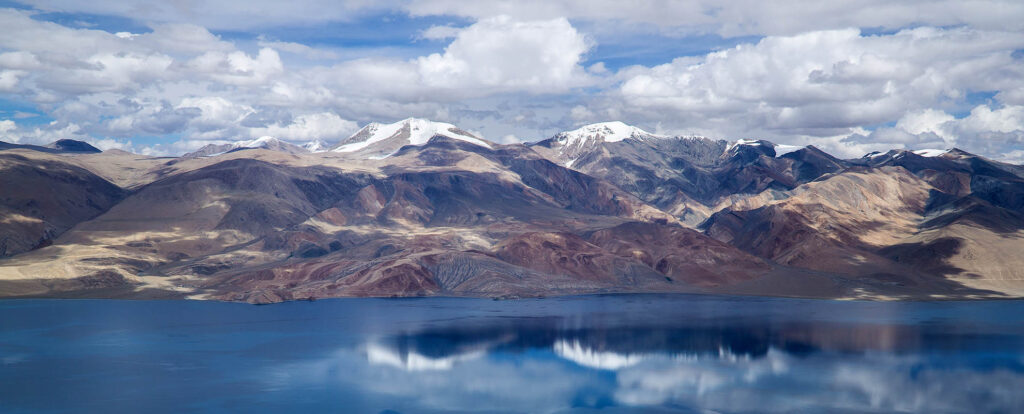
Tsokar Lake
Tsokar means “the white lake”. It is approx 45 kms northwest of the Tsomoriri lake. Tsokar is salt water lake & is so salty that salt extracted are still sold all over Ladakh. The wild ass can be seen grazing on the pastures on the side of the lake. There is a small gompa and the surrounding village THUKJE. Tsokar is breeding ground for Bar headed geese & Rudyshel duck. Birds that can be seen here are Black-necked Cranes, Great Crested Grebe , Tibetan Sandgrouse , Plain-backed Snowfinch , Golden Eagle, Upland Buzzard, Common Kestrel, Lesser Sand Plover , kites etc.
Tsokar lake, is a great spot for Mammals including wolf, fox, weasel, wild ass (Kiang ), blue sheep, argali, marmot, woolly hare etc .
Western Ladakh (Sham valley)
Phyang Monastery,
Phyang Monastery is located just 15 or 16 kilometers west of Leh. It was established in 1515. The site where the monastery now stands was once a part of the numerous monastic propertie. It was offered during the time of Dharma raja Jamyang Namgyal to Chosje Damma Kunga. The hill of Phyang served as the venue of a monastery, known as Tashi Chozong, established in the year 1515. A monastic community was introduced to the monastery and this started, the first establishment of the Digung teachings in Ladakh.”
The monastery is one of only two in Ladakh belonging to the Drikung Kagyu, Dri-gung-pa or Drigungpa School. The Sect is of eight schools derived from the teachings of Phakmadrupa Dorje Gyelpo (1110-1170 CE).
After the monastery was built, it specialized in Digung teachings under Skyoba Jigsten Gonbo. The current head teacher is Apchi Choski Dolma and the reincarnation of Skyabje Toldan Rinpoche is the head lama.
Basgo
Basgo, originally named Bagoo (The Bull Head) is located approximately 40 km from Leh. Although the monastery was built for the Namgyal rulers in 1680, Basgo itself was embedded in the early days of Ladakh and is frequently mentioned in the Ladakhi Chronicles when it was a political and cultural center. It was once the Capital of Ladakh. The monastery is situated on top of the hill towering over the ruins of the ancient town and is noted for its Buddha statue and murals. In the 15th century, a palace was built in Basgo.
Likir Monastery
Likir Monastery or Lhu- khil is located approximately 52 kilometres (32 mi) west of Leh. It is picturesquely situated on a little hill in the valley. The Gelukpa sect of Tibetan Buddhism owns it, and Lama Duwang Chosje established it in 1065 under the command of the fifth king of Ladakh, Lhachen Gyalpo (Lha-chen-rgyal-po). The Ladakhi chronicles mention Likir as having been erected by King Lhachen Gyalpo (Lha-chen-rgyal-po) (1050-1080 CE). The name Likir means “The Naga – Encircled”, representing the bodies of the two great serpent spirits, the Naga-rajas, Nanda and Taksako. It presumably, originally belonged to the early Kadampa order of Tibetan Buddhism.
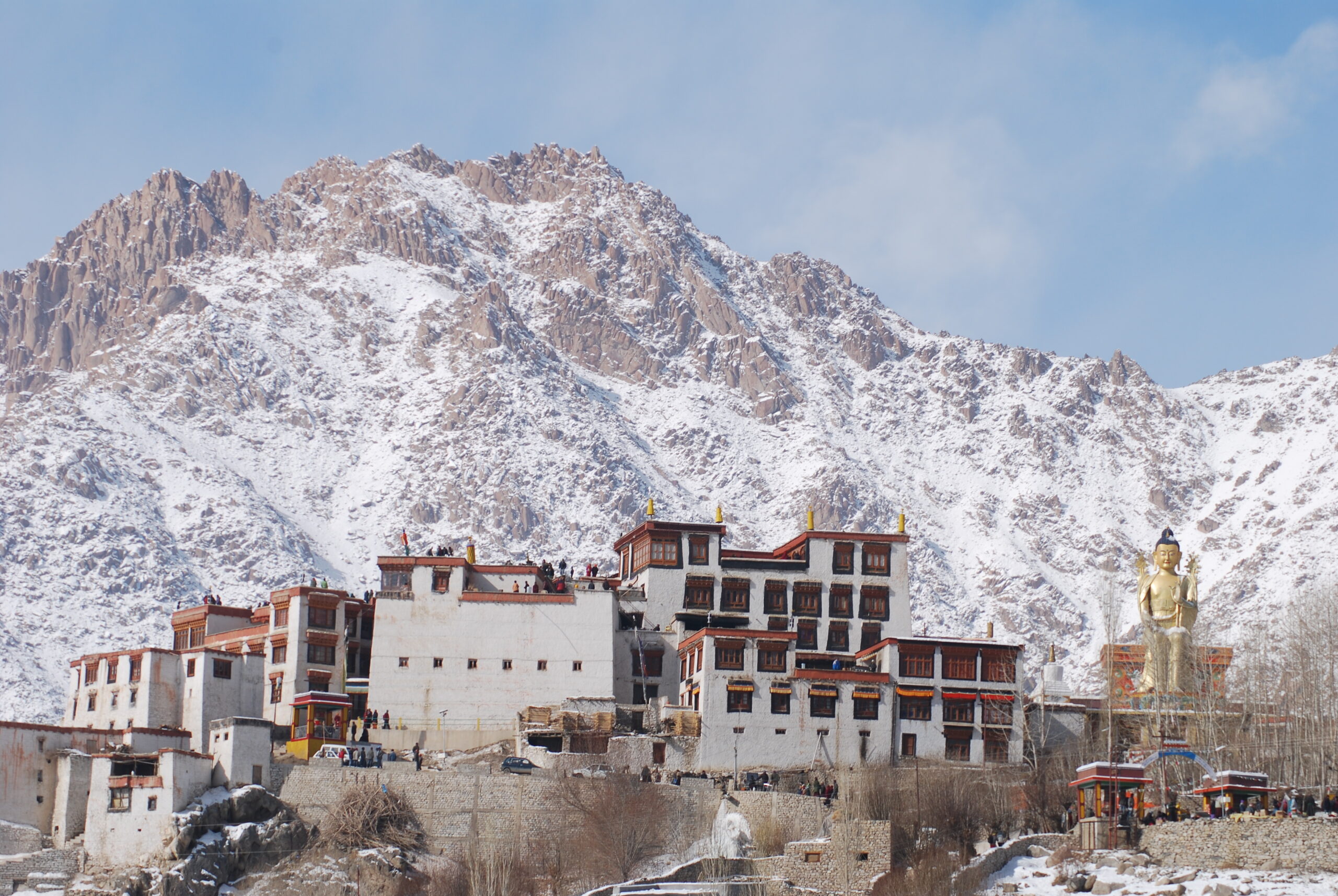
The monastery currently has approximately 120 Buddhist monks and a school, in which almost thirty students study. The Central Institute of Buddhist Studies runs it and teaches in three languages, Hindi, Sanskrit and English. It also serves as the venue of an annual event Dosmochey, the assembly of votive offerings and sacred dances which takes place on the 27th day to 29th day of the 12th month of the Tibetan calendar. It is the seat of the Ngari Rimpoche, the present emanation of whom is the younger brother of the Dalai Lama. Although he does not permanently reside here, he attends for the more important pujas.
Although Likir is relatively isolated, it was once on a major trade route which travelled via Tingmosgang, Hemis and Likir to Leh.
Likir also has the second biggest statue of Buddha maetriya which is the second biggest statue in Ladakh with its height of 80 feet. It was the biggest un till the biggest was built in 2010 at Diskit in Nubra valley of height 105 feet.
Alchi
Lotsava Rinchen Zangpo (958–1055), the famous scholar and translator, founded Alchi temple or the Alchi Choskor in the 10th century. He also established the Lamayuru Monastery, the Wanla, the Mang-gyu, and the Sumda. The temple is located 68 km from Leh. During the tenth century, the Tibetan King Yeshe Od of Guge, in order to spread Buddhism in the Trans Himalayan region, took the initiative by allocating 21 scholars to the region. However, due to harsh climatic and topographic conditions, only two survived, one of them the esteemed scholar and translator Rinchen Zangpo who established Buddhist activity in the Ladakh region and other areas of India including Himachal Pradesh and Sikkim.
During his sojourn there, he also went to the neighboring countries of Nepal, Bhutan and Tibet. Zangpo earned the epithet “Lotsava” or the “Great Translator” due to his accomplishments. He is credited with constructing 108 monasteries in the trans-Himalayan region as part of his mission to spread Buddhism.
The Kadampa order initially brought the monasteries of this period under their control since they did not belong to any of the established Tibetan schools. The Gelukpa order mostly took over the monasteries when their condition deteriorated, except for Lamayuru, which the Drigunkpa sect placed under its control.After worship at Alchi monastery ceased for some reason in the fifteenth century, it also became under the Gelukpa sect controlled from Liker.]
Mangue Temple:
Lotsava Rinchen Zangpo founded Mangue temple in the 11th century, similar to Alchi and Sumda temples. The main temple complex consists of two early temples, namely Sakyamuni temple and Vairocana temple, situated adjacent to each other. Additionally, there are two chapels on either side of the temples, housing large images of two armed and four-armed Maitreya. The Sakyamuni temple, also known as Chenrezig Lakhang, features a beautiful image of Sakyamuni on the North West wall. On the other hand, the Vairocana temple, known as Nangbar Nangzad, showcases an assemblage of sculptures on the NW wall. Regrettably, the monastery lost some of the wall paintings over time, and restoration efforts in the past involved repainting certain sections, specifically those in the Vairocana temple.
The Architectural and Material Heritage divisions of the Delhi chapter of Indian National Trust for Art and Cultural Heritage (INTACH) carried out the architectural conservation of all the temples and chapels, as well as the conservation of paintings of the Sakyamuni temple.
Rizdong Monastery or Rizdong Gonpa
It is monastery is located 73 kms west of Ladakh. Rizdong is also famous as “Yuma Changchubling”. Lama Tsultim Nima established a Yellow Hat monastery at the top of a rocky side valley on the north side of the Indus, to the west of Alchi on the way to Lamayuru, under the Gelukpa order in 1831. The monastery is situated at Ri-rdzong and houses 40 monks. People also refer to the monastery as “the paradise for meditation” due to its extremely strict rules and high standards.
The nunnery, known as “Chulichan (Chomoling),” is located approximately 2 km from the monastery and currently houses 20 nuns.
It is also believed that Guru Padmasambhava meditated in the caves around Rizdong many years before the monasteries were built. It is also inferred that Lamas used to meditate for years in isolation from the rest of the villages in the small caves in the vicinity. They subsisted on one meal a day, which was provided to them by local people through a 1 foot (0.30 m) square window opening in the cave.
Drogpa’s (The Aryans)
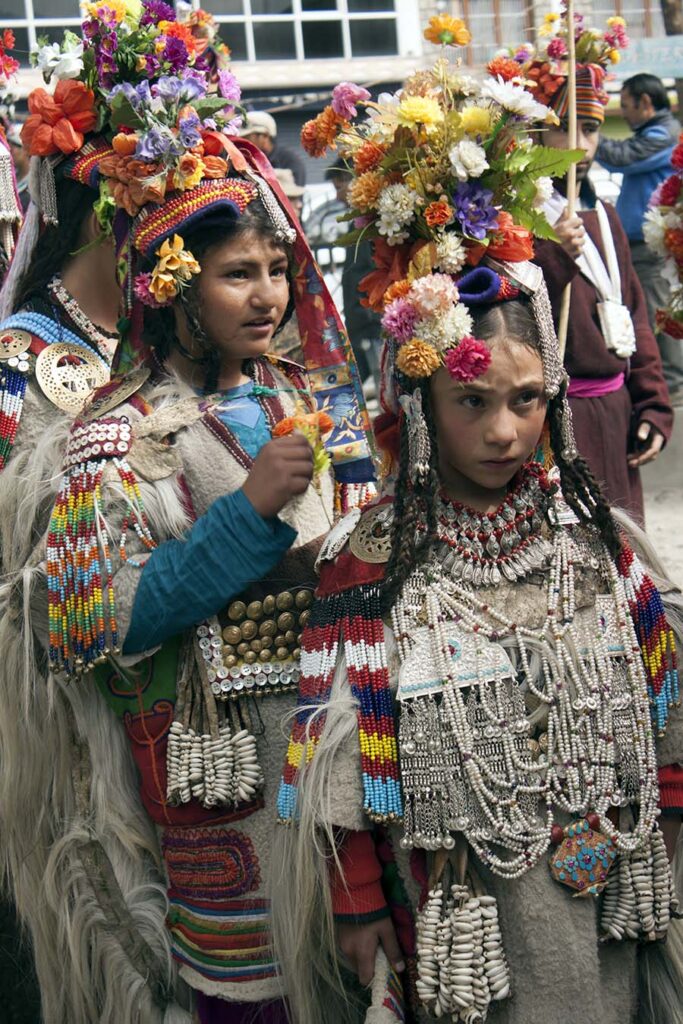
The touris circuits have mapped out the Drogpa regions. Two of India’s five Drogpa villages welcome visitors from outside the country. The villages of Dha and Bema, which are home to the only remaining Dards in the District, are the area’s main draws.
The Dards of the Indus Valley are the purportedly last Aryan peoples. The anthropological and ethnographic significance of these communities is high. A decent road connects all the way to Drogpa, where visitors can rest their heads in a private inn or at a designated camping spot near Khalsi, Dhomkhar, Skurbuchan, Achinathang, and elsewhere.
Lamayuru monastery
Lamayuru monastery or Tharpaling is situated at around 125 kms from Leh on NH1 (National Highway One). Arahat Nyimagon, when he came to this place, he made a prophecy that there will be a monastery here and he made a offerings to Naga spirits with grains. The grains mixed with earth, forming Swastika (Yundrung), giving the monastery its name. It is believed that the Indian scholar Naropa (956-1041 CE) also visited and meditated here. At the southern end of the Lamayuru rock, the oldest surviving building called Seng-ge-sgang temple is attributed to the famous builder-monk Lotsava Rinchen Zangpo (958-1055 CE). The king of Ladakh entrusted Rinchen Zangpo with the task of constructing 108 gompas, and many gompas in Ladakh, Spiti Valley, and the surrounding regions date back to his time.
The monastery festival is called “Yuru Gabgyad”, which takes place on 17th and 18th of 5th month of Tibetan calendar.
Kargil
The Kargil town is 220 kms from Leh which is almost a half way to Srinagar. Kargil is Shia populated town which was a transit point of trade caravans from Tibet Central Asia Yarkand enroute Kashmir until 1949. Since Ladakh was open to tourist in 1974, the Kargil town became a night halt place to tourist travelling between Srinagar-Leh-Zanskar. Kargil, at an altitude of 10.000 feet, has the mighty Suru River flowing through it.In the 15th century, the Shia Muslim community converted this district, which was once predominantly Buddhist, into Islam.
Mulbek
About 40 kms from Kargil towards Leh, Mulbek village boasts a rock-cut image of Maitreya Buddha known as Mulbek Chamba, which is popular among visitors. This place comes on a highway “NH1” to Srinagar or Kargil. It is nine meters in height. There are various interpretations on its date on origin. Some traces this carving back from 7th century and some from early 1st century. Some historian also claim that the image is actually of Buddha Avalokiteshvara (Buddha of compassion), not The Maitreya (future Buddha).
Panikhar;
Panikhar is the best station for undertaking mountaineering expedition to the various peaks of the surrounding valley. Tanyol, the approach base for climbing Mt. Nun is just 6 kms further up the valley along the road. A short walk up the hill slopes from here takes the crossing of Sentik Ridge to the base camp on the rim of the ice plateau. Another very interesting hike is to the Nun-Kun view saddle (3810) in the Parkachik ridge. This requires the 3 hours of walking along the verdant slopes overlooking the fertile valley below.
Zanskar

Info:
Zanskar, the most remote trans-Himalayan valley, located southwest of Ladakh and covers 5000 square kilometres at 13,154 feet above sea level. Kargil takes 2.5 days. Zanskar’s major valleys, Stod (Doda Chu) and Lhungnak (Tsarab Chu), meet below the Padum. Nearly 7 months of the year are unavailable. Winter closes all high passages. Winter access to the valley requires the Chadar hike. The winter frozen river walk is recognised in the tourism sector worldwide. Zanskar’s geological seclusion has preserved Buddhist culture. Islam only reached Parkachik. Padum’s little Muslim community is new.
People can still see many ancient monasteries performing various religious practices. They believe that different Buddhist Saints used some caves in Zanskar to sustain meditation in pursuit of knowledge and enlightenment.The most sacred Sani monastery has a Stupa of Kanishka, believed to be from the period of Kanishka Empire.
At Zanskar , like the rest of the Ladakh , there are many beautiful and old monasteries like the monastery of Sani, Phugtal, Bardan, Karsha, Stongday, Rangdum etc.
Padum;
Padum is 464 kms away from Leh and 234 kms away from Kargil. It is a capital of Zanskar valley and is the administrative head quarter of the region. This place is like a city for the all villages in the valley. There is a small market along the main road with Shops, Hotels and restaurants.
Padum has a small monastery on a hillock called Stakrimo Gonpa which is a a branch of Stakna monastery at Leh and Pibiting Gonpa which is 2 km north of Padum, back towards Karsha. Besides these, there is a famous rock carving of five Dhayani Buddhas (Buddha of five directions and five elements) . The period of these carvings is still unknown.
Zongkul;
It is a isolated and a very beautiful in a near surreal location at the mouth of a valley that leads onward to the Omasila pass on the Great Himalaya Range. Monastery was founded by Maha Siddha Naropa around 1000 years ago, who meditated in a cave above the monastery. It remained the meditation centre for many years. The footprint of Naropa can be seen in the caves even today. This monastery has more than 30 Monks and Nuns.
Sani;
Sani is a village which is around 6 km away from Padum. It’s in the north west of Padum along the Stod River. It is believed that Guru Padmasambhava visited Sani and meditated for many years. Maha Siddha Naropa is visited the place and meditated. Sani Nasjal is a monastic festival that happens during 15th to 20th of sixth month of the Tibetan calendar.
The very ancient Kanika Stupa/chorten is located at Sani. This Stupa lies behind the monastery. This Stupa is popularly associated with the Emperor Kanishka from 1st century. In a small shrine near Stupa, we can see old icons and murals preserved behind the glass.
Karsha Gonpa;
The Karsha monastery, like every big and majestic monastery in Ladakh and Tibet, Karsha is built like a fortress and defiant against the Hillside. It is the largest monastery in Zanskar. It is around 9 km away from Padum across the river and it takes 2 hours on foot to reach the place. Gonpa was founded by translator Phagspa Sherab from Zanskar. Later it got improved or upgraded by Dorjay Sherab and Sherab Zangpo of Stod. At present, it is the largest Gelukpa monastery with more than 90 monks.
Zangla;
Lying 13km in the north east of Padum, the road continues along the plain above the sunken gorge of the Zanskar River, narrowing as it approaches Zangla, the ancient capital of Zanskar. The ruins of Zangla Fort appear high on a rickety wooden suspension bridge to enter Zangla village.
The Fort is a square three storied with narrow structure balconies that look out from the top floors.This was where Alexander Csoma de Koros, the 19th century Hungarian Tibetologist, stayed and worked for a year in 1823. Later he studied under the Lamas of Zangla, read Buddhist texts, published analysis of the Kangyur and compiled the first Tibetan- English dictionary in 1834.
A narrow passage way leads into the Fort. Many rooms have fallen, but it is still possible to climb up to Csoma’s small dark room on the 3rd floor. And also you can visit the Nunnery of Zangla.
Phugtal Gonpa;
The ‘Phugtal’ monastery is picturesquely set on the mountain that looks like a bird’s nest and lies in the west of Padum. Phagspa Sherab founded this monastery, and later introduced a monastic community. The Phugtal festival takes place on 18th and 19th days of the 12th month of Tibetan calendar.
Bardan
Bardan Monastery is a 17th-century Buddhist monastery, approximately 12 kilometres south of Padum. It belongs to the Dugpa-Kargyud monastic order and was one of the first monasteries of this sect to be established in Zanskar. The monastery also ran several smaller hermitages in the area.The monastery consists of a large Dukhang or assembly hall which has some grand statues of Buddhist figures and several small stupas in clay, bronze, wood and copper.

